Introduction
In the second half of 2024, Alarm Phone was alerted to 482 boats in distress in the central Mediterranean Sea. In the whole of 2024, we worked on 803 distress cases in this region. This is the second highest annual figure for the central Mediterranean Sea, following the record year of 2023, when we were alerted to 1,203 cases. Overall, arrivals via Libya and Tunisia to Europe decreased in 2024, down from about 157,600 people in 2023 to approximately 66,600 people.
Many have tried to cross the sea but did not succeed. This is also due to mass interceptions carried out by Libyan and Tunisian authorities who receive continuous support by Europe. In the past year, new deals were concluded between the EU, its member states, and authoritarian forces in Tunisia and Libya, often to specifically increase interception capacities. According to IOM, 21,762 people were intercepted at sea and forcibly returned to Libya. Following an estimate by the Tunisian Forum for Economic and Social Rights (FTDES), between 60.000-80.000 people were intercepted at sea by Tunisian authorities and returned there, often to be forced into the desert to Algeria or Libya. IOM estimates speak of 1,700 deaths and disappearances in the central Mediterranean Sea in 2024. We should make clear, however, that any statistical count of interceptions or deaths and disappearances can only ever be rough estimates that need to be treated with caution.
Despite the ongoing assault on solidarity at sea, the actors of the civil fleet have remained resilient and effective over the past year. According to the Civil Maritime Rescue Coordination Centre, of which Alarm Phone is a member, 12,410 people were rescued by the civil fleet in 2024.
In this analysis, we provide a comprehensive chronology of the second half of 2024 (the first six month were covered here), offering in great detail an account of developments as they unfolded in the central Mediterranean Sea. As nobody else is doing so, we need to create our own archive of migrant struggles, acts of solidarity, and forms of border violence at sea. Also for 2025, we promise to continue in our struggle alongside people on the move. In our daily practice, we struggle against borders, for ferries, not Frontex, and the freedom of movement for all.
Chronology: July-December 2024
July
In July, Alarm Phone was alerted to 53 boats in distress, among them 43 departing from Libya and five from Tunisia. For the others, the departure place is unclear. NGO vessels rescued a total of 25 boats that month – not all of them had alerted Alarm Phone. No boats were rescued by merchant vessels. The Italian Coastguard rescued at least 30 boats. Often, they rescued boats when they had almost reached Lampedusa, and they also coordinated some rescue operations of boats heading towards Sicily or Calabria. One boat was rescued by the Armed Forces of Malta (AFM). We know of five interceptions by the so-called Libyan Coastguard. About Tunisian interceptions we rarely receive reliable figures. We learned about four shipwrecks (two of them Alarm Phone cases) in July.
On 1 July, a group in a rubber boat near Garabulli, Libya called Alarm Phone and reported that one of their boat’s tubes was deflated and water was entering. The so-called Libyan Coastguard did not pick up the phone. Only on the next day, we received the information that the approximately 80 people in distress were intercepted and returned to Libya, where they were detained.
On 2 July, 26 people in distress off the Tunisian islands of Kerkennah alerted Alarm Phone. The Tunisian authorities first told us that they could not find the boat but on 3 July they informed us that the people were brought to Sfax.
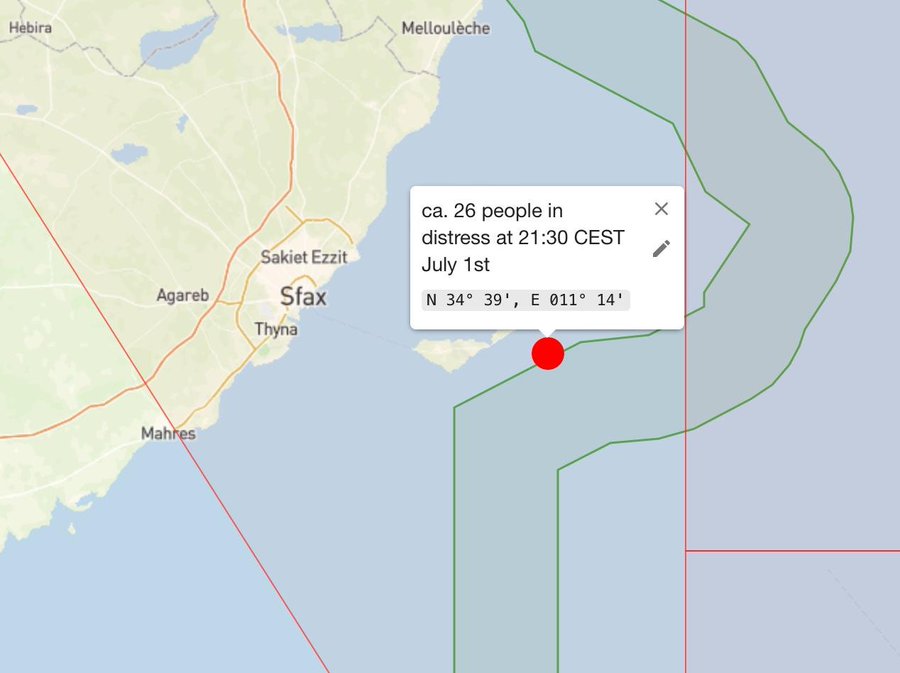
Map showing the position of the boat in distress. Source: Alarm Phone
On 5 July, the crew of Humanity1 rescued 291 people from three boats in distress. A Libyan speedboat was nearby but kept distance. The Italian rescue coordination center instructed Humanity1 to bring only 111 of the rescued people to Lampedusa, the others to the distant port of Bari, instead of bringing all together to a nearby port in Sicily.
On 6 July, the Nadir found a rubber boat in distress. Alarm Phone had alerted about the 33 persons who had left Libya two days earlier. The crew distributed water and life-saving equipment and accompanied the boat towards Lampedusa.
On 7 July, we learned about two shipwrecks: One boat had left from Sfax, Tunisia and sunk in international waters. 44 survivors were rescued by a Tunisian fishing boat, three people went missing. The other boat had left Zuwara, Libya, two days earlier and capsized on a rock off Lampedusa. 44 people survived and reported that two people had not made it to shore.
On the same day, the Nadir and the Sea-Eye 4 rescued 60 persons who had left Libya in a rubber boat, were in severe distress and had alerted Alarm Phone.
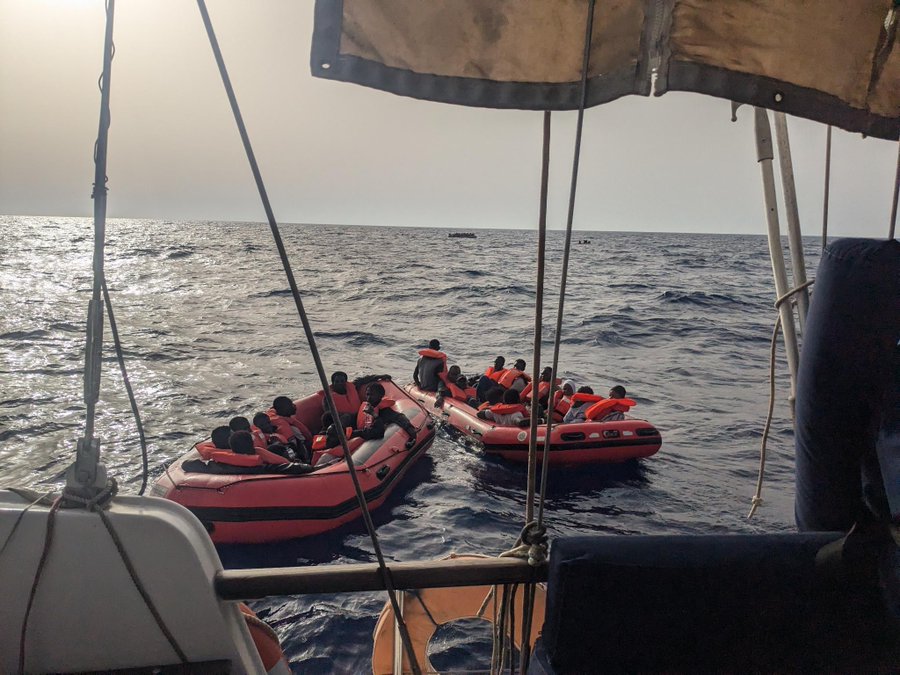
Rescue operation by the Nadir. Source: @resqship_int
On 8 July, the same civil rescue ships reacted to another alert from Alarm Phone for 50 people in distress in the Maltese Search and Rescue zone.
On the same day, the Ocean Viking rescued 93 people from a double-deck wooden boat. During the rescue, two unidentified boats approached the scene. Two masked men embarked on the boat with survivors still onboard, creating panic and people jumping in the water.
On 10 July, the MSF team on the Geo Barents spotted 12 people in distress on a small fiberglass boat and rescued them. On the same morning, an asset of the Libyan Stability Support Apparatus dangerously approached the area where the Geo Barents was conducting another rescue. This triggered fear in people who jumped into the water. The MSF team managed to rescue all 87 people.
On 11 July, we learned that 953 people had arrived in Lampedusa over 24 hours, most of them arriving from Libya (Tripoli, Zawiyah and many from Tajura), only some from Tunisia (Sfax).
On 13 July, Alarm Phone alerted authorities to a group of 19 people in distress in Maltese SAR. One day later, we were informed that the Italian Coastguard had rescued this boat to Sicily.
On 15 July, 16 lives were at risk off Sicily. We alerted the Italian Coastguard and learned that they were found and rescued in the night.

Map showing the position of the boat off Sicily. Source: Alarm Phone
On the same day, testimonies collected in an Alarm Phone report about violence of the Tunisian Coastguard against people on the move were published.
On 16 July, the Sea-Eye 4 was threatened by militias of the so-called Libyan Coastguard. They set fire to a nearby empty boat and circled the Sea-Eye 4, telling them to leave.
On the same day, media reported that a boat from Benghazi with 41 people on board reached Kythera island, Greece.
On 17 July, 21 people survived a shipwreck. Their boat sunk after they had alerted Alarm Phone. The Nadir crew found the 21 survivors in the water despite it being dark, because one shipwrecked person managed to hold up a light. Short time later, another boat in distress was alerted. The Nadir stabilised the 60 people and later the Italian Coastguard embarked them and also six urgent medical cases from the Nadir.
On the same day, while Meloni and Piantedosi travelled to a conference on migration in Tripoli, Frontex was patrolling the area between Libya and Lampedusa and 38 sub-Saharan Africans were arrested in Tunisia after clashes with coastguards who had intercepted their boat during an attempt to migrate to Europe.
On 18 July, the Ocean Viking reported that they had rescued 38 people on an overcrowded fiberglass boat in the Maltese SAR and later 17 people after an alert from Alarm Phone.
On 19 July, the Geo Barents performed two rescues: 49 people on an overcrowded rubber boat in the Libyan SAR zone and 130 people on a double-deck wooden boat, alerted by Alarm Phone and Seabird in the Tunisian SAR region.
On 20 July, the Aurora rescued 71 people in an operation together with the sailing ship Trotamar III. The airplane Seabird had spotted the distress case.
On 22 July, a new wave of expulsions from Libya to Niger was reported by Alarme Phone Sahara. 463 people were expelled. The same sources reported that an estimated 10,000 people, mostly Niger nationals, had been arrested in Libya by General Haftar’s forces for deportation.
On the same day, a group of 62 people fleeing Libya alerted Alarm Phone. The so-called Libyan coastguard carried out an illegal pushback from within the Maltese SAR zone.
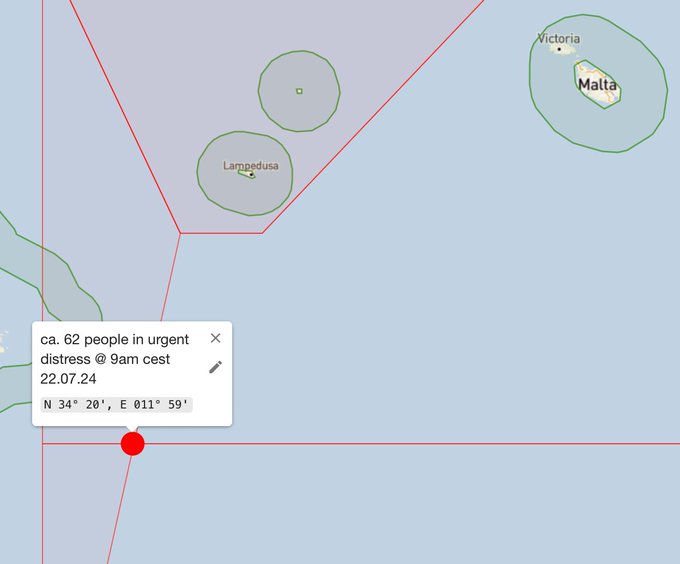
Map showing the position of the boat just crossing the SAR border. Source: Alarm Phone
On 23 July, Frontex reported that some days earlier they had spotted an overcrowded boat that was taking water. They had dropped a life raft and together with the Maltese Rescue Coordination Center, 54 people had been brought to shore.
On the same day, prosecutors in Crotone, southern Italy, accused two members of the Italian Coastguard and four police officers of involuntary manslaughter, following an investigation into a shipwreck which had killed 94 people in 2023 near Cutro.
On 25 July, media reported that the so-called Libyan Coastguard was waiting for official confirmation that they could conduct interceptions in Tunisian waters.
On 26 July, Alarm Phone was alerted to a rubber boat with 103 people on board, escaping from Libya. We called on EU authorities to rescue the distressed to safety. Instead, they were forcibly returned by the so-called Libyan Coastguard.
On the same day, Amnesty’s Secretary General denounced the rollback of human rights in Tunisia. The institution of justice had been brought to heel, while arrests and arbitrary prosecutions were multiplying.
On 28 July, three arrivals of 153 people in Lampedusa were reported: two small boats were rescued to the island, one boat, carrying Moroccans and Tunisians, arrived independently.
On 29 July, another 48 people who had left from Tunisia, arrived on two boats in Lampedusa.
On 31 July, journalists reported that, starting in August, migrants rescued at sea by Italy might be taken to asylum processing centers in Albania, a non-EU country.
On the same day, a shipwreck occurred south of Lampedusa. The Nadir crew could evacuate 80 people on their boat and embark them later on a vessel of the Italian coastguard. The Nadir also rescued 110 people who had alerted Alarm Phone.
August
In August, Alarm Phone was alerted to 107 boats in distress, among them 91 departing from Libya and 14 from Tunisia. For the others, the departure place is unclear. NGO vessels rescued a total of 31 boats that month – not all of them had alerted Alarm Phone. Three boats were rescued by merchant vessels, two of them were brought to Greece, the other one was forced back to Libya. The Italian Coastguard rescued at least 36 boats. Often they rescued boats when they had almost reached Lampedusa, and they also coordinated some rescue operations of boats heading towards Sicily or Calabria. No boats were rescued to Malta. One boat was rescued by the Greek Coastguard to Crete. We know of 18 interceptions by the so-called Libyan Coastguard. About Tunisian interceptions we rarely receive reliable figures. We learned about four shipwrecks (three of them Alarm Phone cases) in August.
On 1 August, several boats in distress were rescued: The Nadir took 27 people on board and brought them to Lampedusa. The Ocean Viking assisted 29 people on a fiberglass boat in the Italian SAR and later transferred them to a coastguard ship. The Humanity 1 rescued 60 people and a cat who had fled from Tripoli. Alarm Phone alerted for a boat carrying 45 people, which was found and rescued by the coastguard of Augusta and brought to Sicily.
On 3 August, journalists got access to the locations of the Italian-orchestrated detention facilities in Albania. This horrible project planned to force rescued migrants into 15-metres-large rooms with four beds each, a mini penitentiary, monitored by dozens of CCTV cameras.
On the same day, a shipwreck occurred off Libya. Seabird discovered a rubber boat with around 80 people in critical condition. Nearby, two boats of the so-called Libyan Coastguard were taking people on board. They left two bodies behind. According to Libyan sources, they had been later recovered and transferred to the Red Crescent.
On 4 August, Alarm Phone was informed about 106 people onboard a white rubber boat and alerted authorities. We never managed to get in touch with them, but according to relatives, they were pushed back to Libya, after their Thuraya phone was stolen by the so-called Libyan Coastguard.
On 5 August, Alarm Phone was alerted by 17 people on a fiberglass boat near Sicily. After three days at sea, they did not have food or water left and their engine stopped. We alerted authorities but RCC Malta hung the phone up on us. Eventually, the Italian Coastguard found the group in distress and brought them to Sicily.
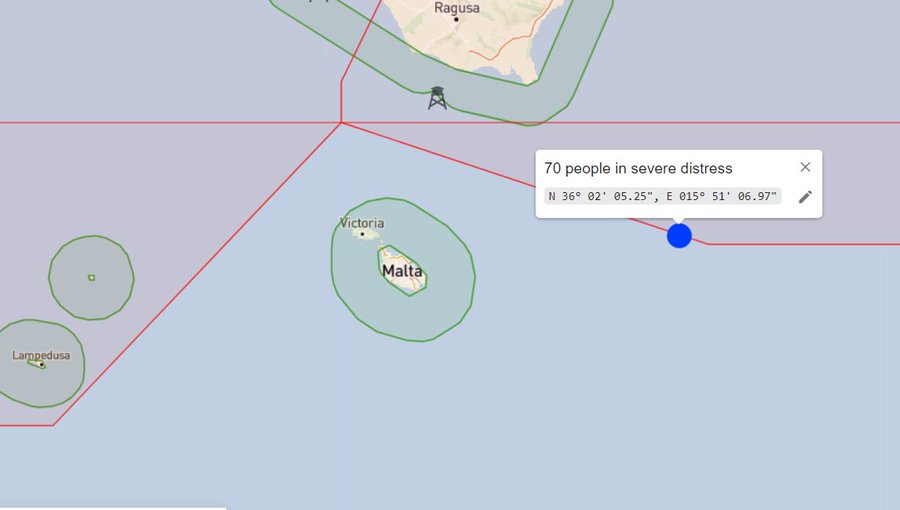
Map showing the position of the boat in distress. Source: Alarm Phone
On 6 August, an interception off eastern Libya was reported: 50 people on a drifting rubber boat were brought back to Tobruk.
On 7 August, 40 people in distress off Sicily, who had alerted Alarm Phone, were found and rescued by the Italian Coastguard.
On 8 August, Alarm Phone alerted authorities to 65 people on a deflating rubber boat, some already in the water. One day later we received information that the people were forcibly taken back to Libya by the so-called Libyan Coastguard.
On 9 August, we heard of two boats on the way from eastern Libya to Crete who had alerted Alarm Phone two days before. One boat, carrying 52 people, was rescued by a cargo ship and later brought to Greece, the other one with about 30 people on board was forced back to Libya, coordinated by the Greek Coastguard.
On the same day, the Humanity 1 was on the way to a boat in distress in Maltese SAR zone, but the crew received orders from the so-called Libyan Coastguard to stay away. The Libyan patrol boat reached the boat before the Humanity 1, so they had no choice but to stay at a distance and watch the illegal push back. Also people of another boat in distress where a merchant vessel was already on scene could not be rescued by the Humanity 1. The people were forced back to Libya, including two people who had been already on the merchant vessel.
On 11 August, 13 people who had alerted Alarm Phone, escaping from Libya, were found and rescued by the Humanity 1.
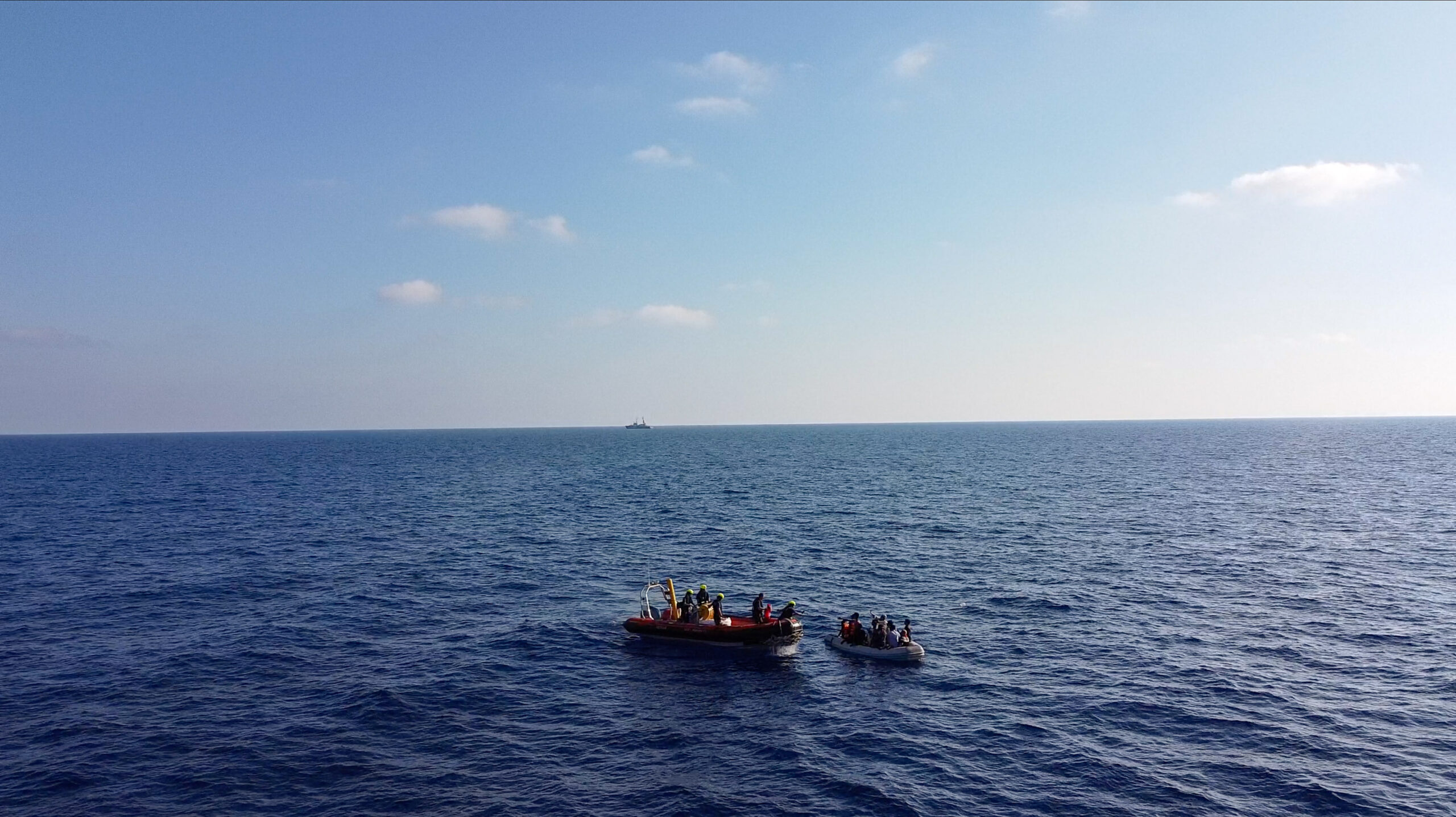
Rescue operation. Source: @soshumanity_en
On 12 August, 785 arrivals in Lampedusa were reported for the past 48 hours. 65% of the departures were from Tunisia, several boats from Sfax with people from sub-Sahara Africa and Tunisia on board.
On 13 August, 46 people in distress in the Maltese SAR zone alerted Alarm Phone. One day later the Pozzallo Coastguard confirmed that the people were rescued and brought to Sicily. (map)
On 14 August, the Tunisian Garde Nationale conducted several operations, intercepting over 200 individuals from sub-Saharan African nationalities according to sources at the port of Sfax. Probably the actual number was much higher than what had been reported.
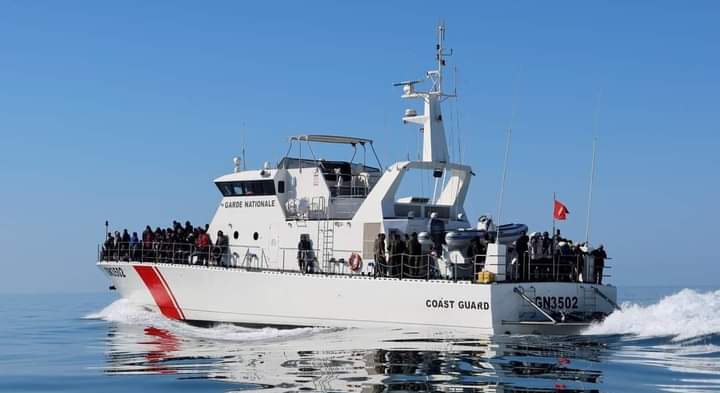
Patrol boat of the Tunisian Garde Nationale. Source: @brirmijihed
On 15 August, the Geo Barents rescued 57 people on a rubber boat who were trying to escape from Libya and had alerted Alarm Phone.
On the same day, about 125 people who had alerted Alarm Phone in distress between eastern Libya and Crete were intercepted and forcibly returned to Tobruk.
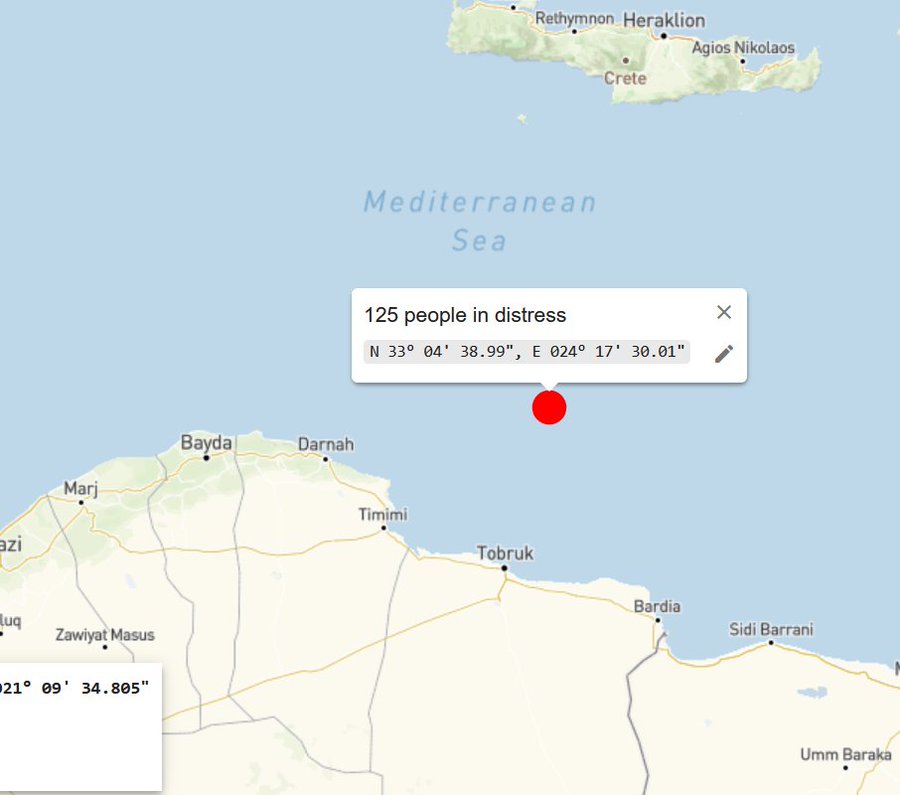
Map showing the position of the boat in distress. Source: Alarm Phone
On 19 August, people from Bangladesh, Pakistan and Yemen were arrested in Tobruk and brought to a detention centre for deportation.
On 20 August, Alarm Phone was alerted by 45 people adrift off Tunisia. We fear that they were intercepted by the Tunisian Coastguard, at risk of deportation into the desert.
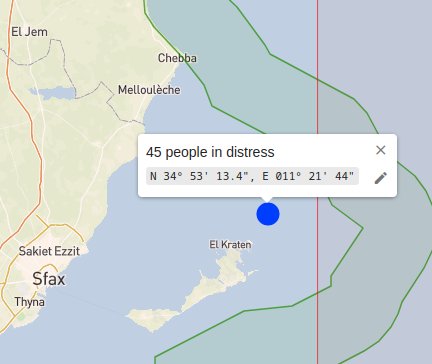
Position of the boat adrift off Tunisia. Source: Alarm Phone
On 21 August, 55 people between Libya and Crete alerted Alarm Phone from the Greek SAR region. One day later the Greek Coastguard confirmed that three merchant vessels had found the people and they arrived to Gavdos, a Greek island near Crete.
On 25 August, 791 arrivals in Lampedusa were reported of the day before, 210 on that day. There were also many arrivals in Calabria.
On 26 August, a group on a white rubber boat that was already deflating alerted Alarm Phone. Twelve people had gone overboard and were in the water. Authorities were alerted but only Nadir went there and was able to take them on board.
On 27 August, the Tunisian authorities launched another massive campaign against people on the move. Twelve sub-Saharan Africans were arrested, all carrying asylum application documents. Fifteen people were deported to desert areas at the Algerian border without food and water and on the way two of them died.
On the same day, Alarm Phone was alerted by about 70 people in distress in the Maltese SAR zone. After authorities had continuously ignored several alerts about this rubber boat at risk of capsizing, we learned that more than 12 hours (!) after the initial Mayday had been issued by a Frontex airplane, the Italian Coast Guard finally went out and brought the people to Lampedusa.
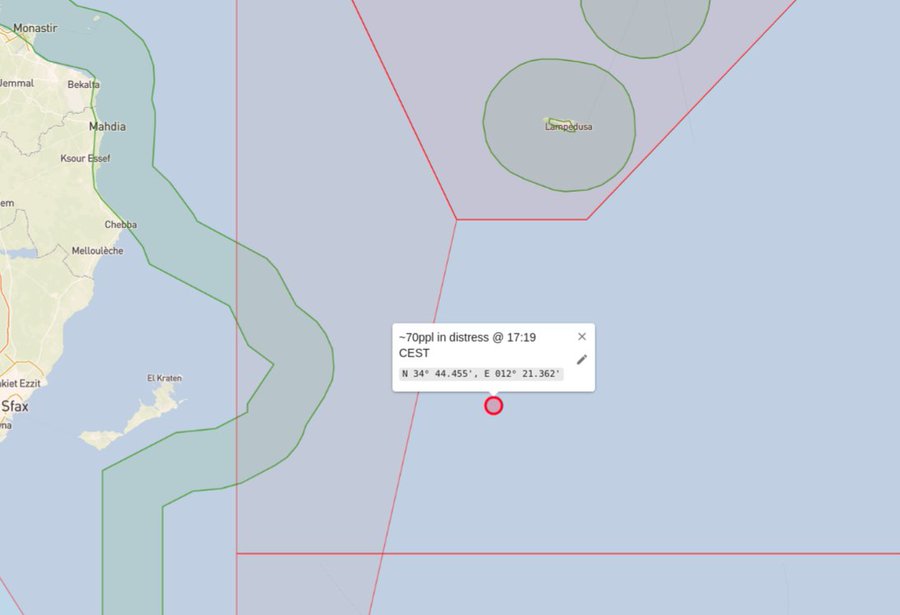
Map showing the position of the boat in Maltese SAR zone. Source: Alarm Phone
On 28 August, the Italian government announced that they had delivered three patrol boats to the Tunisian Coastguard. They will be used to intercept people at sea, detain them and deport them to the desert at the borders.
On 31 August, the Nadir supported 14 people on their way to Lampedusa. The people had left Djerba, Tunisia, three days earlier but had lost course. As the engine still worked, the Nadir crew accompanied them for four hours, until the Italian Guardia di Finanza evacuated them. A few hours later, the Nadir reached a wooden boat in distress through Alarm Phone. The 31 people had left Libya the day before and were unable to manoeuvre. The crew took the people on board and brought them to Lampedusa.
From 25 to 31 August 2024, 979 migrants were intercepted and returned to Libya, according to IOM.
September
In September, Alarm Phone was alerted to 99 boats in distress, among them 85 departing from Libya and 10 from Tunisia. For the others, the departure places are unclear. NGO vessels rescued a total of six boats that month – not all of them had alerted Alarm Phone. Three boats were rescued by merchant vessels, two were brought to Greece, the other one forced back to Libya. The Italian Coastguard rescued at least six boats. Often they rescued boats when they had almost reached Lampedusa, and they also coordinated some rescue operations of boats heading towards Sicily or Calabria. No boats were rescued to Malta. Six boats were rescued by the Greek Coastguard to Crete. One boat was forced back to Egypt. We know of six interceptions by the so-called Libyan Coastguard. About Tunisian interceptions we rarely receive reliable figures. We learned about six shipwrecks (two of them Alarm Phone cases) in September.
On 1 September, the Office of the Attorney General in Libya announced the release of 1,300 people on the move, who were in a warehouse of human smugglers in the municipality of Shouerf, many of whom were tortured, raped and asked for ransom from their families.
On the same day, Libyan broadcasters confirmed the assassination of Bidja – Abdelrahman Milad – a notorious smuggler and trafficker and official commander of the Naval Academy in Libya.
On 2 September, the Nadir assisted two boats in distress, carrying 61 and 129 people, and took some of them on board until the Italian Coastguard came and brought them to Lampedusa. Almost 370 people had arrived there the day before and landings continued from Libya and Tunisia.
On 3 September, we learned from a news report that a group of 69 people on the way from eastern Libya to Crete who had alerted Alarm Phone was rescued by a cargo ship. Authorities confirmed that they would be transferred to Chania, Crete.
On the same day, another boat shipwrecked on the same way. Nine people were rescued off the coast of Tobruk and brought to Libya, one body was recovered from the sunken boat. At least 23 people are feared dead.
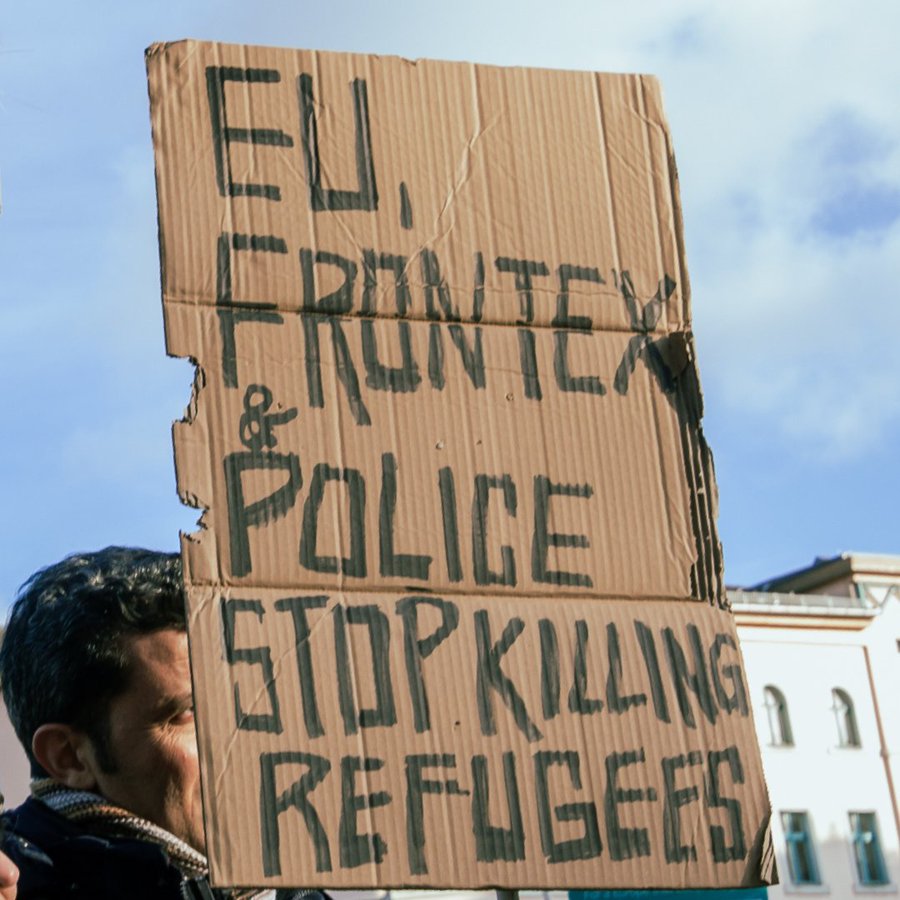
Photo published by @seawatch_intl
On 4 September, another shipwreck was reported: 21 people went missing after a boat had capsized a few miles from Lampedusa. Seven survivors were rescued by the Italian Coastguard. Due to matching evidence, Sea-Watch has strong reasons to believe that the boat in distress was already reported three days prior to Italian and Maltese Authorities by its Airborne operations. Despite the information, no intervention was launched in time. Alarm Phone found out that it is likely the same boat that we had alerted authorities about at 16:40h CEST, September 2.
On 5 September, the Greek Coastguard told us that the rescue of a boat carrying 41 people who had alerted Alarm Phone on the way to Crete was ongoing.
On 6 September, Alarm Phone alerted authorities about a boat in distress not far from Lampedusa. Eventually, the 79 people were rescued to Lampedusa by the Italian Coastguard.
On 7 September, already for four days, there was no Civil Fleet in the Central Mediterranean. While NGO ships are detained on false grounds in a cynical political game, MRCC Rome regularly refuses responsibility for groups at risk of drowning. The supposed “Rescue Coordination Centre” in Malta is not responsive at all.
IOM reported that from 1 to 7 September, 804 people were intercepted by the so-called Libyan Coastguard.
On 8 September, Alarm Phone alerted authorities about a group of 50 people in distress southwest of Lampedusa. They were monitored by a merchant vessel, but feared interception by Tunisian border guards. Seabird also found this boat which was already taking water.
On the same day, another shipwreck happened: A boat with eleven people sank after five hours at sea. They had departed from Sabratha. Four survivors swam two days before being rescued. Seven people went missing.
On 9 September, attacks on people on the move were reported from Tunisia: Near Sfax, three young men from West Africa were attacked by Tunisian citizens who fired live bullets. The young men had gone to search for water as they had no clean water in the olive fields of Sfax. The four survived but with severe injuries.
On the same day, about 50 people in distress in the shared rescue zone of Malta and Italy alerted Alarm Phone. Eventually, they were rescued to Pozzallo, Sicily.
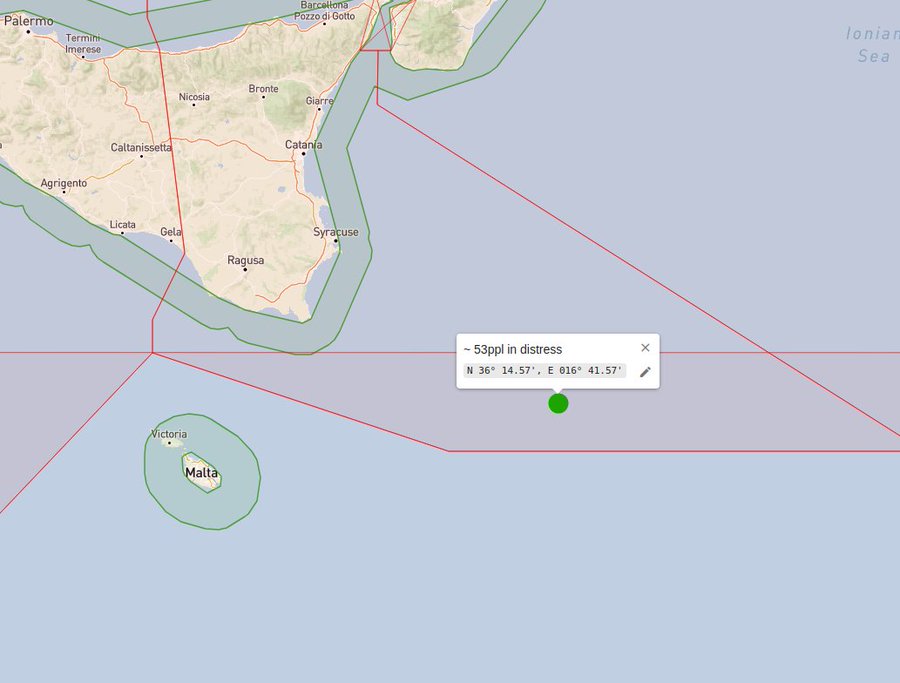
Map showing the position of the boat near Sicily. Source: Alarm Phone
On 11 September, the Sea-Watch 5 was detained. Just hours before, the detention of the Geo Barents was suspended by the court of Salerno.
On the same day, 34 people in distress between Libya and Crete alerted Alarm Phone. During the night, the Greek Coastguard confirmed that the people were found by a merchant vessel, transferred to a Greek patrol boat and brought to Crete.
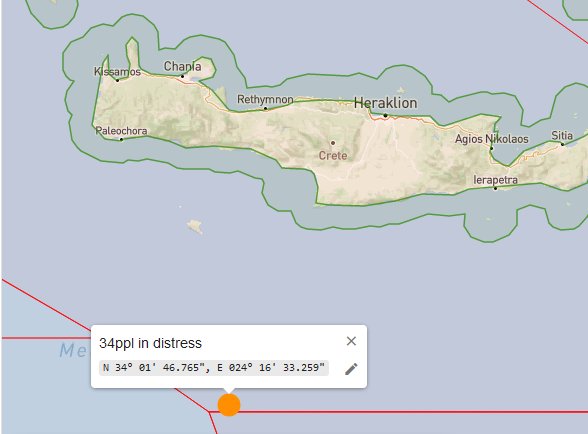
Map showing the position of of the boat between Libya and Crete. Source: Alarm Phone
On 12 September, it was reported on social media that Tunisia’s naval fleet was expanding rapidly: two boats from Japan, three from Italy, and six more incoming (three from the US and three from Italy). This influx, since 2011, highlights Tunisia’s increasing role as Europe’s border guard.
On the same day, Tunisian authorities deported about 130 people on the move to the desert and abandoned them at the Algerian border. They still remained missing on 16 September.
On 13 September, Tunisian youth protested against President Saied’s autocratic regime and the transformation of Tunisia into a repressive police state.

Protest in Tunisia, published by @brirmijihed
On 14 September, media reported that an Italian prosecutor asked a judge to sentence right-wing League leader Matteo Salvini to six years in prison over his 2019 decision to prevent more than 100 migrants from landing in the country. The then interior minister, who is currently serving as deputy prime minister and transport minister in Giorgia Meloni’s government, has been charged with kidnapping following his decision that left the migrants stranded at sea.
On 15 September, we learned about another shipwreck off Sfax: The boat of 60 Gambians, including four women and two babies, capsized – only four people survived.
On the same day, the court in Catania did not validate the detention of the first asylum seeker locked up in the Pozzallo centre after its recent reopening, stating that Egypt cannot be considered a safe country.
On 18 September, Alarm Phone was alerted by a group of 45 people heading from eastern Libya to Crete. They had lost track and were struggling with strong waves and winds. Authorities in Egypt informed us that the people were intercepted and brought to the port of Matruh, although Egypt is not a safe country.
On the same day, the Mare Jonio was placed under administrative detention after a surprise inspection by the Italian Coastguard. It would be able to set sail only if it unloaded all their rescue equipment, otherwise it would lose its seaworthiness. Mediterranea announced that they would appeal against this detention.
On 19 September, 63 people adrift in international waters south of Crete who had alerted Alarm Phone the day before were taken onboard the merchant vessel CL FUGOU. The ship was heading towards Libya. We tried in vain to reach their company, Maersk Tankers. UNHCR reported that the merchant vessel “prevented for their safety their handover to Libyan Coast Guards“, but we learned later that the people were returned to Libya nonetheless.
On the same day, 22 people on their way to Crete had alerted us. The Greek Coastguard told us that they had located the group and rescued them.
On 20 September, media reported that the EU Commission said it would be sending independent observers to Tunisia to investigate allegations of human rights violations.
On 21 September, the Nadir took 37 people on board who had alerted Alarm Phone from a rubber boat which had already lost air and the engine was damaged.
On 22 September, Tunisian networks for Rights and Freedom announced a demonstration.
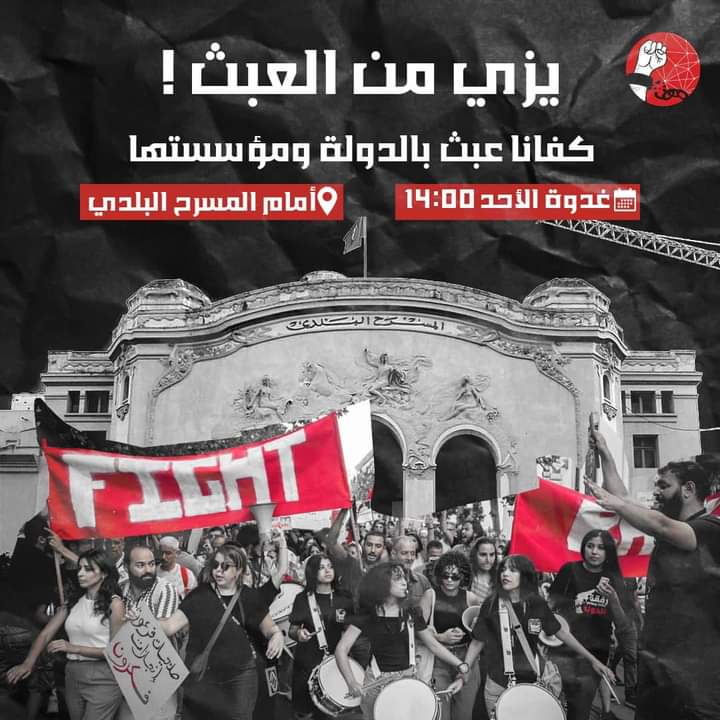
Poster with the call for the demonstration. Source:@brirmijihed
On the same day, another illegal pullback of a boat in Maltese SAR that had alerted Alarm Phone zone was organised under EU responsibility.
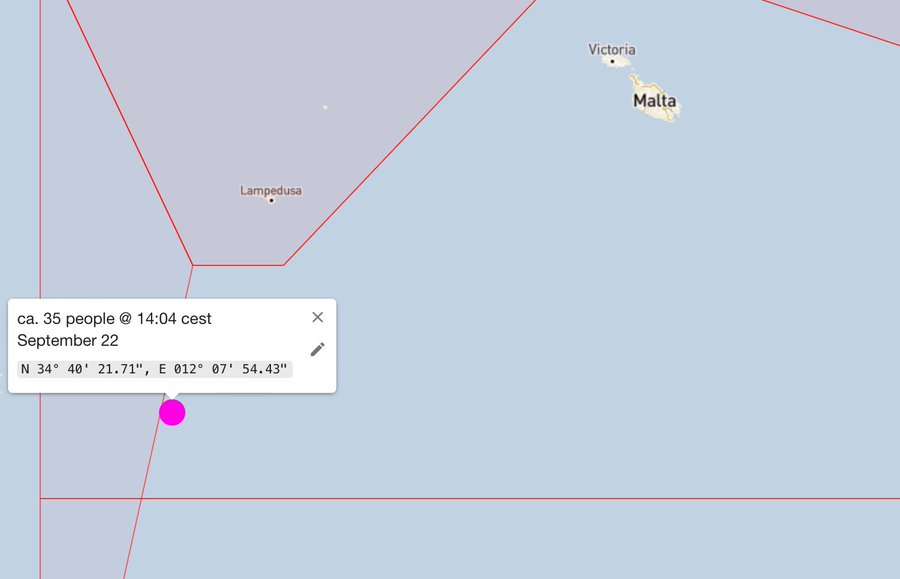
Map showing the position of the boat in Maltese SAR. Source: Alarm Phone
On 23 September, we learned that two days earlier, a boat carrying 90 people had sunk off the coast of Libya after departing from Garabuli. A relative had alerted Alarm Phone the night before. About 30 people survived, while everyone else drowned.
On the same day, the Italian authorities imposed again two separate detention orders on the Geo Barents.
On 24 September, the Nadir, heading towards a boat in distress in Maltese SAR, was threatened and aggressively forced to leave by the so-called Libyan Coastguard.
In the same night, the Nadir crew supported 93 people on two boats. Following an alert from Alarm Phone, the crew was able to locate the first boat despite low visibility in the dark. Shortly after, the Italian Coastguard arrived and rescued everybody. Afterwards, the Italian Coastguard and the Nadir did a joint search for the second boat. With the Nadir tender on standby the Coast Guard transferred the people onto their ship and took them to Lampedusa.
On 26 September, Alarm Phone alerted authorities to a group of 62 people adrift southwest of Lampedusa. Eventually, they were rescued by the Italian Coastguard.
On the same day, we were informed by a relative that a group of 47 people who had stranded on an island close to Kerkennah and had alerted Alarm Phone on 22 September was deported to the Algerian border. The people reported that their phones had been stolen by the Tunisian authorities.
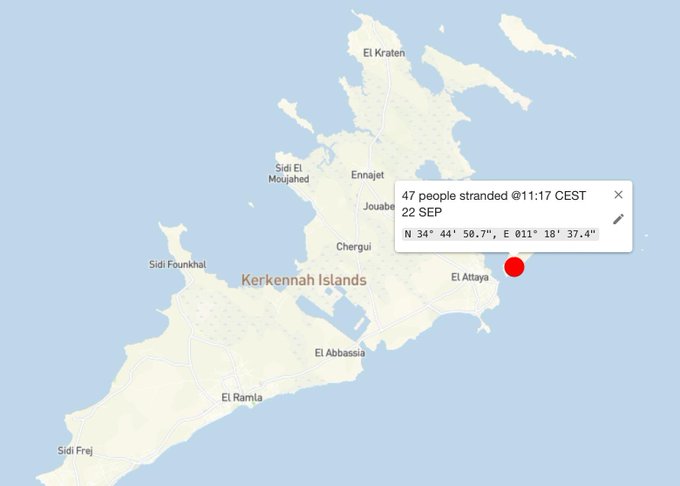
Map showing the position of the people stranded on Tunisian island. Source: Alarm Phone
On 27 September, the Italian undersecretary Mantovano said during a press conference: “The opening of centres in Albania has faced problems due to the terrain, issues during construction and unfavourable weather events that occurred in August and a few days ago. By the first ten days of October the facility will be ready for testing and after a few days fully operational.”
On the same day, the Nadir reported about two rescues during the night: Alarm Phone had alerted about 45 people on a boat that had started sinking. A second boat with 25 people onboard appeared. All people were taken aboard the Nadir, received medical treatment and could safely disembark in Lampedusa at midday.
On 28 September, Alarm Phone was alerted about 54 people in distress in the Italian SAR, on the Ionian route to Calabria. After alerting authorities, we learned by a relative that they were rescued to Italy.
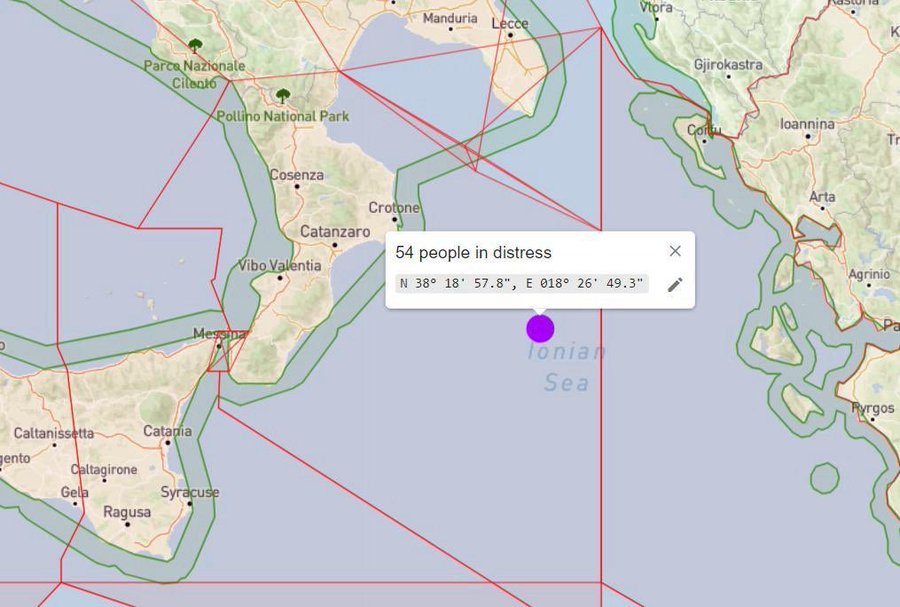
Position of the boat in distress off Calabria. Source: Alarm Phone
On 29 September, 35 people in distress who had alerted Alarm Phone were rescued to Lampedusa thanks to the sailing ship Trotamar III.
On the same day, a shipwreck off Lampedusa was reported: A boat with 58 migrants on board, departing from Sfax in Tunisia, had capsized a few meters from the coast of Capo Ponente. The timely intervention of some tourists on a yacht and some people of Lampedusa allowed 55 people to be rescued, while three people went missing.
On 30 September the Tunisian National Guard confirmed a shipwreck near Djerba. Twelve bodies were discovered, 29 survivors could be rescued, most of them Tunisians. On the boat were more than 40 people.
October
In October, Alarm Phone was alerted to 75 boats in distress, among them 65 departing from Libya and seven from Tunisia. For the others, the departure place was Turkey (one) and Lebanon (two). NGO vessels rescued a total of 15 boats that month – not all of them had alerted Alarm Phone. Two boats were rescued by merchant vessels. The Italian Coastguard rescued at least four boats. Often, they rescued boats when they had almost reached Lampedusa, and they also coordinated some rescue operations of boats heading towards Sicily or Calabria. One boat was rescued to Malta. Three boats were rescued by the Greek Coastguard to Crete. We know of 16 interceptions by the so-called Libyan Coastguard. About Tunisian interceptions we rarely receive reliable figures. We learned about seven shipwrecks (two of them Alarm Phone cases) in October.
On 1 October, the so-called Libyan coastguard abducted 26 people in distress who had alerted Alarm Phone from deep within the Maltese Search and Rescue zone.

Map showing the position of this boat in Maltese SAR zone. Source: Alarm Phone
On the same day, a boat carrying 57 people, most of them Tunisians, sank off Djerba. There were 32 survivors. 15 bodies, including of three infants, were recovered. Many remained missing. Two people were brought to hospital, in critical medical condition.
On 2 October, 21 landings in Lampedusa over 24 hours were reported. Almost 900 people were rescued by the Italian coastguard or arrived alone.
On the same day, a shipwreck occurred off Zuwara, Libya. Eleven people survived, three died, four went missing. The survivors were in the water for more than five hours before being rescued by a Tunisian fishing boat. They were then handed over to the Libyan military, who took them to the next city and released them.
On 3 October, the Libyan Ministry of Interior announced the launch of an expanded campaign to deport “illegal immigrants“. Already on the day before, 180 Nigerians were returned to Lagos.
On 4 October, raids in Tobruk were carried out after several boats had departed from there towards Crete. One of these boats that had alerted Alarm Phone was rescued by the Greek Coastguard near the small island of Gavdos.
On the same day, a new method of the Tunisian coastguard when intercepting migrants at sea was reported: confiscating boats and forcing passengers to swim to shore.
On 5 October, Alarm Phone received distress calls of two boats from eastern Libya towards Crete. One of them, carrying 36 people, was rescued by a merchant vessel and transferred to Gavdos.
On 6 October, only 27,7 percent of voters participated in Tunisia’s presidential elections – the victory of Kais Saied was expected, not least due to the repression against most of the other candidates. 62 human rights organisations had published a joint statement two days before to urge the EU and its member states to act. Before and after the elections, Tunisia is not safe – neither for those fleeing nor its civil society.
On 8 October, the National Guard in Tunisia announced that the coastguard intercepted more than 2,500 people on the move and arrested dozens of “human traffickers“ following a large-scale operation that began five days before in the coastal region of Sfax. The operation, involving hundreds of security forces supported by anti-terror units, aircraft, and trained dogs, was ordered by President Kais Saied in response to a record number of people arriving in Lampedusa by boats from North Africa.
On the same day, Alarm Phone was relieved to hear that 85 people at risk of drowning south of Lampedusa were rescued to the island.
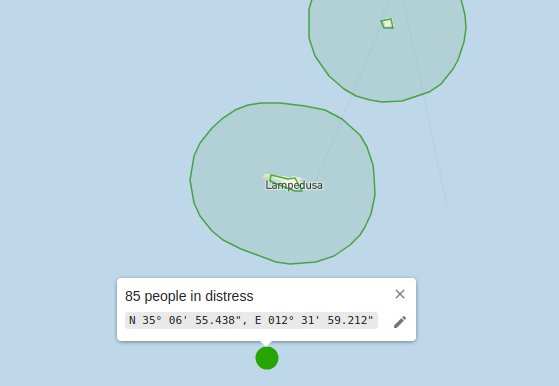
Map showing the position of the boat south of Lampedusa. Source: Alarm Phone
On 9 October, Mare Jonio, the ship of Mediterranea Saving Humans set sail from the port of Trapani towards Lampedusa for its 19th mission in the Central Mediterranean Sea.
On 10 October, Alarm Phone was alerted to a boat in distress carrying 136 people in international waters. They were intercepted by the so-called Libyan coastguard and forced back to Libya.
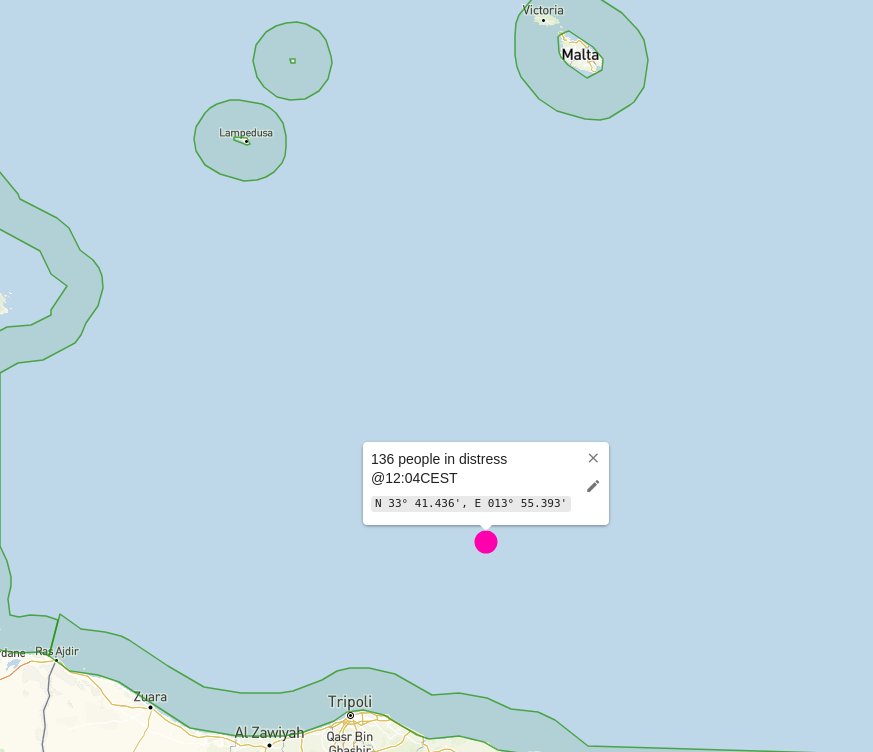
Map showing the position of the boat in distress. Source: Alarm Phone
On the same day, 70 people in distress were rescued by a Maltese tanker south of Gavdos and brought to Crete. Also the Ocean Viking and the Humanity 1 performed rescues.
On 11 October, Alarm Phone celebrated its 10th anniversary. Several articles were written about the anniversary in the days before. Our network also published an anniverary book. During our Alarm Phone meeting in Dakar, Senegal, we commemorated over 200 people who died when Malta and Italy had left them to drown exactly 11 years ago. We remembered them and all who followed. We will not forget them and we will continue to fight against murderous border regimes.
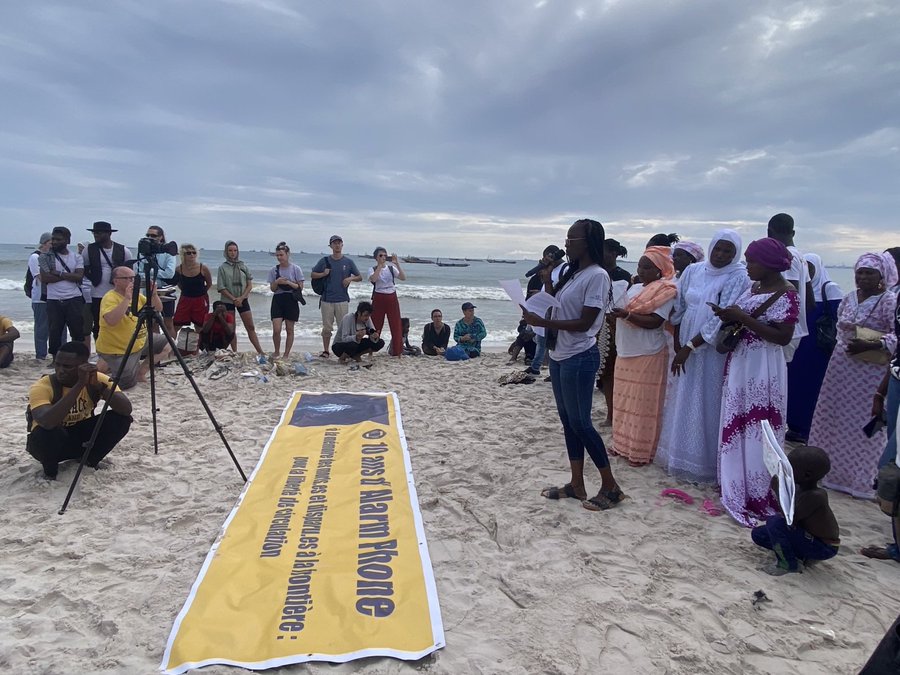
Photo of the CommemorAction on 11 October on a beach near Dakar, Senegal. Source: Alarm Phone
On the same day, the first group of people was brought to Albania on the Libra ship of the Italian Navy. Only 16 people (from Egypt and Bangladesh) who had been rescued by an Italian coastguard vessel, together with ten others, had been transferred to the Libra. For the people to be transferred, a first screening was made on board to verify that they had the expected requirements: proven to have left “safe countries”, considered male and “not vulnerable”. The week before, the Schengjin and Gjiader centers had become operational.
On 12 October, Alarm Phone was alerted by 52 people in distress east of Malta. After many hours of non-assistance, we learned that the people were finally rescued and disembarked in Malta.

Map showing the position of the boat east of Malta. Source: Alarm Phone
On 14 October, the Mare Jonio rescued 58 people on a boat adrift who had alerted Alarm Phone. Landings in Lampedusa continued with 300 people arriving within a few hours and over 400 people arriving the day before.
On 15 October, Sea-Eye 4 rescued 22 people after a life-threatening manoeuvre: masked men had forced 22 people to jump off a moving boat in international waters and then left them unassisted.
On the same day, IOM Libya announced that – together with the Ministry of Defence – they had inaugurated the Sabratha Training Center to enhance training on human rights-compliant search and rescue, border management and migration. IOM also launched a human rights training program for 14 Ministry officers.
On 16 October, European Commission president von der Leyen cited the Italy-Albania deal as a possible model for reducing irregular arrivals to Europe.
On 17 October, the Nadir performed a difficult rescue of 71 people in rough sea conditions. They had fled Libya in a rubber boat and had reached out to Alarm Phone, urgently asking for help. They had been at sea for three days.
On 18 October, the court in Rome did not validate the detention of people rescued at sea within the Italian detention center for repatriation of Gjader in Albania. The measure had been ordered by Italian authorities for the twelve people, who were among sixteen people (ten from Bangladesh and six from Egypt) who had been transported to Albania by the Libra ship of the Italian Navy. According to the court, both countries of origin could not be considered safe. The remaining four people had already been returned with a patrol boat to Italy: two declared themselves minors and therefore would not fall under the agreement between Rome and Tirana; two others reported health problems. Italy’s Interior Minister Matteo Piantedosi announced an appeal by the government against this ruling. The judges’ decision also casts doubt on the EU’s hardline plans.
On 19 October, 52 people stranded on the Tunisian island Roumadia close to Kerkennah alerted Alarm Phone. We informed authorities, hoping they would be taken to the mainland, but we fear an illegal deportation to the desert took place.
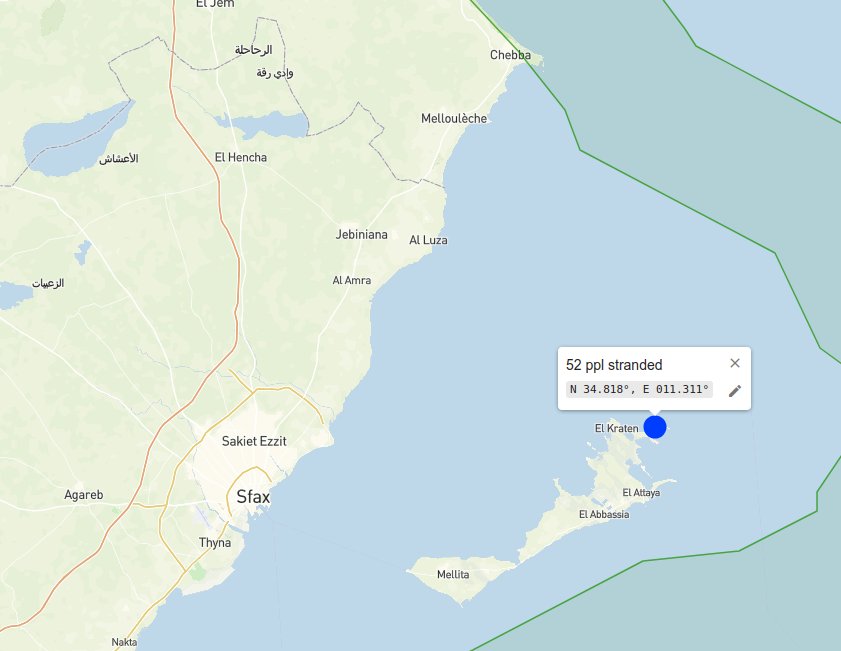
Map showing the position of the 52 people who stranded on a Tunisian island. Source: Alarm Phone
On 20 October, the Italian Council of Ministers approved a decree-law indicating the countries to which immediate repatriations were to be made. The list of so-called safe countries of origin dropped from 22 to 19. The government hopes that the courts, which had not confirmed the detention of people from those countries, would change their attitude. But a ruling of the EU Court on 4 October had specified that a country cannot be safe if even a part of its territory does not guarantee the protection of the rights of all citizens.
On 22 October, the Tunisian President Saied received a call from Italy’s Prime Minister Meloni to congratulate him on his re-election. They discussed strengthening Tunisia-Italy relations and addressing “irregular migration through Tunis-Rome process, focusing on returning irregular migrants to their home countries”.
On the same day, the European Court of Human Rights ordered Malta to pay a compensation of 84.000 Euro to six young migrants who had suffered a breach of their rights when they were detained upon their arrival. The applicants, six Bangladeshi nationals, had arrived in Malta on 18 November 2022 after being rescued at sea. At the time, they were 16-17 years old.
On 23 October, the EU Ombudsman criticised the Commission for not being transparent about the human rights information it relied on before signing an agreement with Tunisia, which includes EU funds for border management. She also called on the Commission to set out explicit criteria for suspending EU funding.
On 28 October, a delegation from the European Commission visited Tunisia to review “Tunisia’s commitment to the Memorandum of Understanding signed in July 2023 between Tunisia and the European Union.” The visit came amid growing criticism of the high human cost of this memorandum, which has turned Tunisia into a “service provider” for guarding European borders and aims to establish detention centers for migrants.
On the same day, the court of Crotone, Italy, judged the SOS-Humanity’s seizure illegitimate.
The cooperation with Libyan authorities was not necessary, because what they do cannot be qualified as “rescue”.
On the same day, Alarm Phone alerted authorities to a group in distress who had fled from Libya, heading to Crete. A merchant vessel in vicinity, the BTG MISTI, told us that they did not get any orders from authorities to assist the group. One day later, we learned from relatives as well as the so-called Libyan Coastguard that the group was found and returned back to Libya where they were sent to a prison in Benghazi.
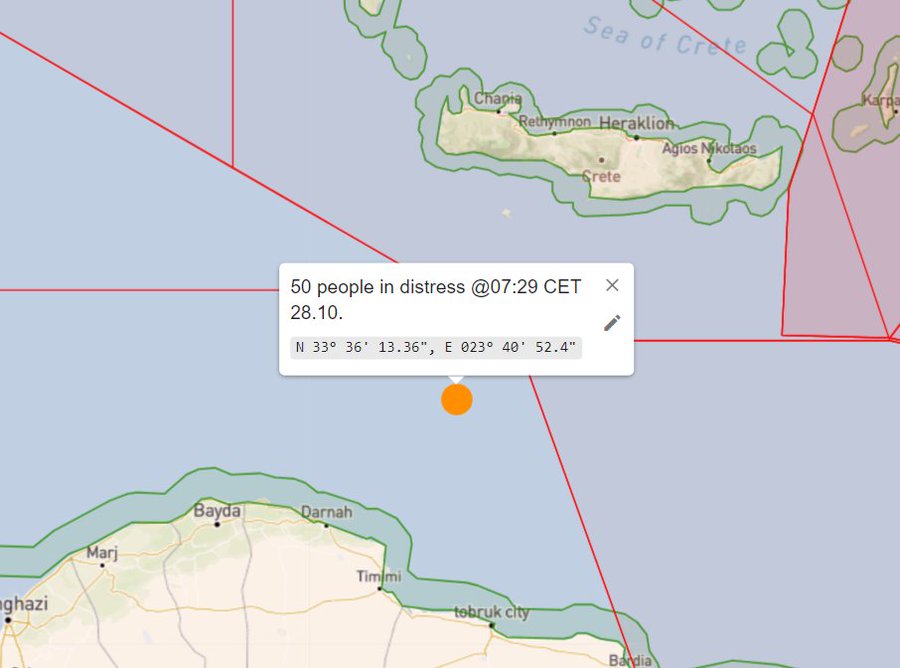
Map showing the position of the boat forced back to Libya. Source: Alarm Phone
On 29 October, a shipwreck off eastern Libya occurred. A boat carrying 13 passengers capsized near the border with Egypt. Only one person survived.
On 30 October, the Ocean Viking rescued 25 people from a wooden boat in distress in the overlapping Tunisian/Maltese SAR zone. They had left four days ago from Sabratha, Libya, and alerted Alarm Phone.
On the same day, Meloni discussed North Africa cooperation at her fourth visit to Libya. At the same time, along the coast of Tunisia, the bodies of 19 people were recovered, victims of yet another shipwreck caused by the repressive migration policies of the Italian government and the EU.
On 31 October, the Life Support vessel conducted two rescues in international waters of the Maltese SAR area. Both boats, carrying 38 and 34 people, had alerted Alarm Phone.
November
In November, Alarm Phone was alerted to 95 boats in distress, among them 86 departing from Libya, eight from Tunisia and one from Egypt. NGO vessels rescued a total of 24 boats that month – not all of them had alerted Alarm Phone. One boat was rescued by a merchant vessel to Malta. The Italian Coastguard rescued at least twelve boats. Often, they rescued boats when they had almost reached Lampedusa, and they also coordinated some rescue operations of boats heading towards Sicily or Calabria. Three boats were rescued by the Greek Coastguard to Crete. We know of 16 interceptions by the so-called Libyan coastguard. About Tunisian interceptions we rarely receive reliable figures – this month we learned about three, but there were many more. We know of four shipwrecks (two of them Alarm Phone cases) in November.
On 1 November, Alarm Phone alerted authorities to 44 people in distress who had escaped Libya four days before and were in the Maltese SAR zone. But RCC Malta did not order a nearby merchant vessel to rescue. Only one day later we learned that the people had moved into the SAR zone shared by Malta and Italy where they were sheltered by a merchant vessel until the Italian Coastguard arrived.
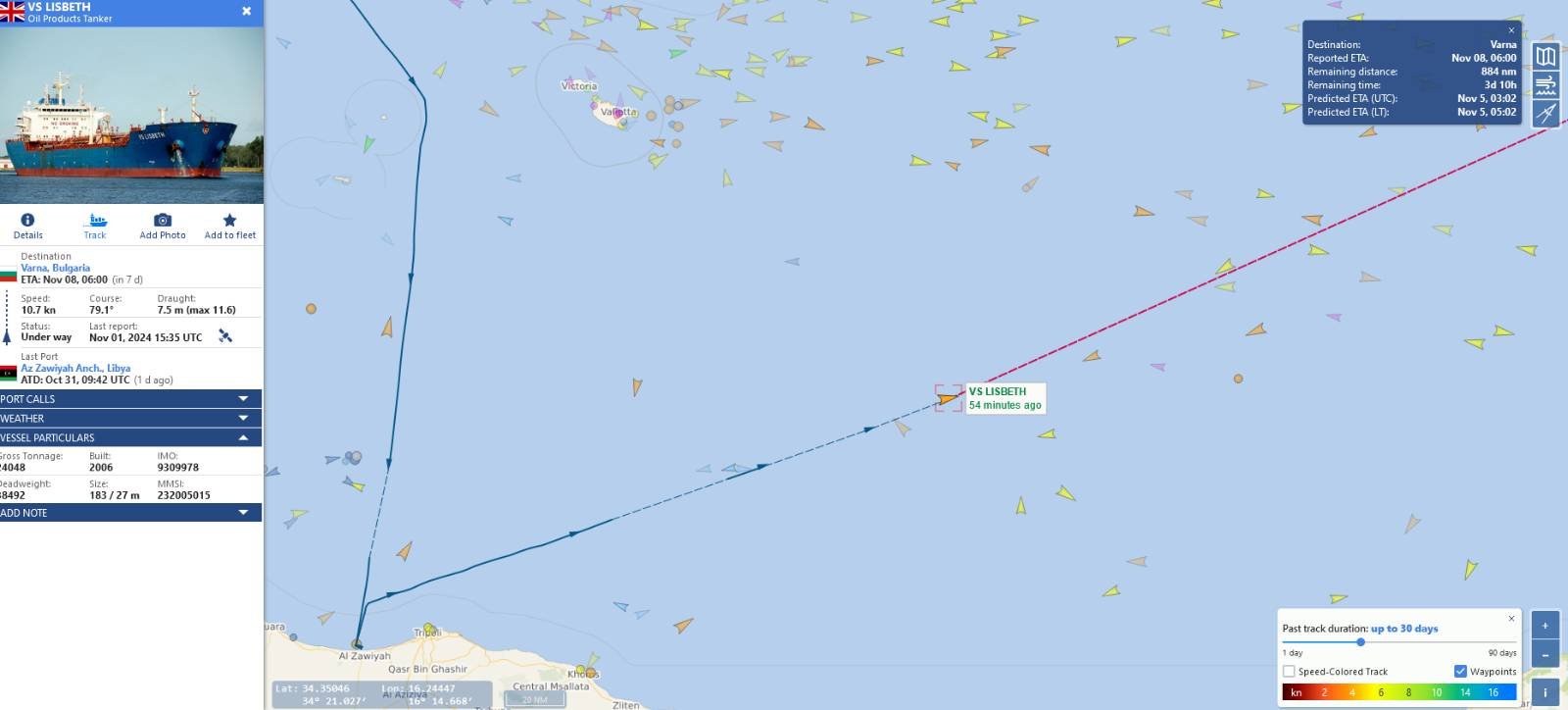
Map from vesselfinder.com with the track of the merchant vessel that sheltered the boat in distress. Source: Alarm Phone
On the same day, landings of about 500 people in Sicily, Calabria and Lampedusa were reported, most of them rescued by the Italian Coastguard.
On 2 November, Mediterranea published a statement against the attempt by Italian authorities to block the Mare Jonio and about their appeal against it.
On 4 November, the court of Catania annulled the detention of a person who had arrived from Egypt and had applied for refugee status in Pozzallo. According to the court, a list of ‘safe countries’ “does not exempt the judge from the obligation to verify the compatibility” of such “designation with European Union law” and “in Egypt there are serious violations of human rights’ that ‘affect the freedoms of a democratic system”.
On the same day, the Libra of the Italian Navy arrived in Lampedusa and six Egyptian people who had been rescued by the Italian Coastguard, were transferred to the Libra and, after a screening, to Albania.
On 6 November, supporters of the El Hiblu 3 came to Malta to show their solidarity at the court hearing of the three young men. They are still accused because of their struggle to prevent the pushback of about 100 people to Libya.
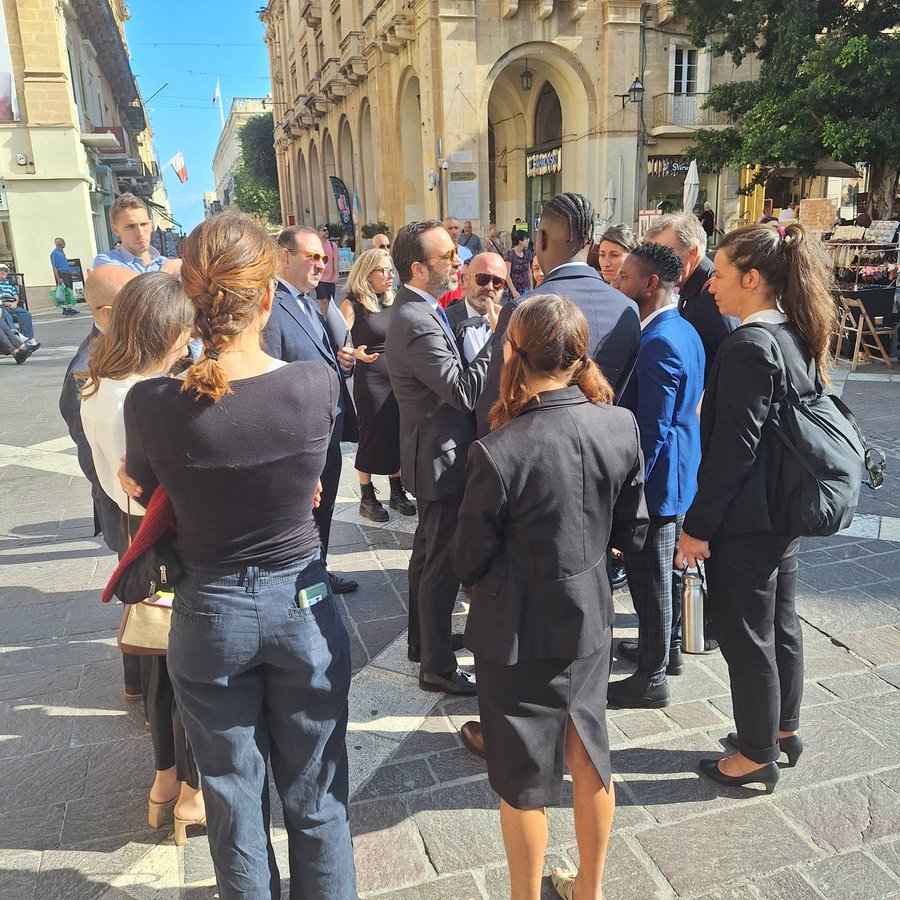
Photo taken in Valletta near the court hearing, published by @FreeTheEH3
On the same day, the Ocean Viking rescued a group of seven people who had called Alarm Phone in distress at sea and later performed another rescue. In cooperation, the Sea-Eye 5 and the Trotamar III also rescued people from boats in distress.
On 7 November, Alarm Phone alerted a distress case of an overcrowded wooden boat with 37 people on board. The Nadir crew found the boat, provided life jackets and stabilised the situation, until the Italian Coastguard came and took everyone safely to Lampedusa.
In the night between 7 and 8 November, the Tunisian Coastguard rammed a boat, carrying 80 people, and killed 52 of them. The survivors were deported to the desert and sold to Libyan militias.
On 10 November, a Libyan navy ship arrived in Tunisia to participate in an international training, organised by the US Africa Command (AFRICOM). One of the aims is combating “illegal immigration“.
On 11 November, seven people who were on the Libra ship had to be brought back to Italy. Their detention in Gjader, Albania, was suspended by a judge in Rome, pending an EU Court ruling. Media reaction some days later: Italy’s Albania asylum deal has become a political disaster for Meloni.
On 12 November, Nadir witnessed a Libyan interception in the Maltese SAR zone, 20 miles north of the Libyan SAR border.
On the same day, Alarm Phone was alerted by 73 people in distress south of Greece. Later, two more boats carrying 19 and 45 people called us on their way from Libya to Crete. According to relatives, media reports, and Greek Coastguard, all three boats were rescued to Crete.
On 13 November, Libyan special naval forces, the patrol vessel TBZ 6, intercepted 74 people who were heading towards Greece on an overloaded boat north of Derna, eastern Libya.
On 14 November, two people drowned as a boat capsized off Al Khums, Libya. 26 of the 30 people on board were rescued by Libyan authorities.
On 15 November, another shipwreck off Tunisia was reported to Alarm Phone by a survivor. The boat, carrying 52 people, had capsized two days before, due to harsh weather conditions. While the iron boat quickly sank, some were able to stay afloat until they were accidentally found the next day by Tunisian fishermen who brought them back to Sfax. 15 or 16 people remained missing.
On the same day, Alarm Phone was in contact with a group of about 90 people in distress, east of Malta. The boat had run out of fuel and was drifting. On the following day, relatives informed us that the boat had been rescued to Italy.
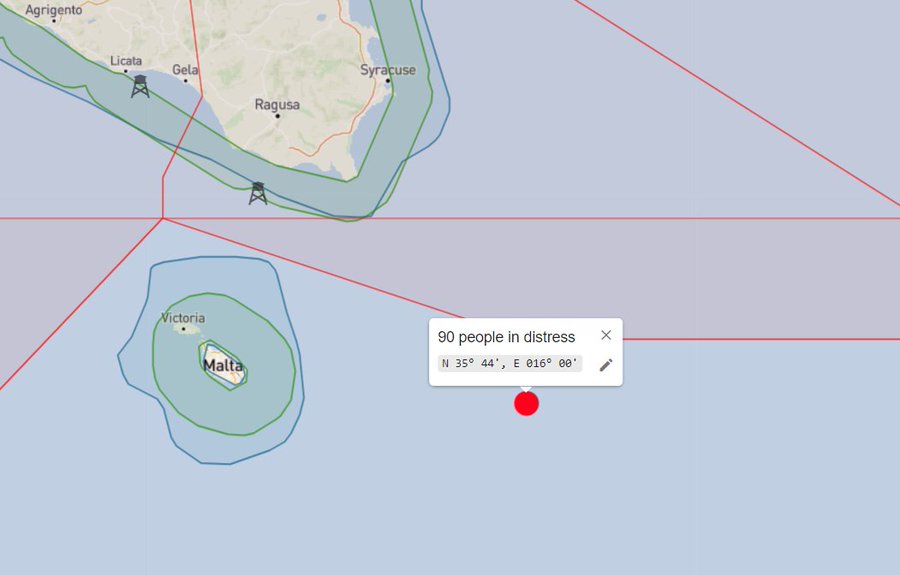
Map showing the position of the boat east of Malta. Source: Alarm Phone
On 16 November, Alarm Phone was alerted to 30 people in severe distress when fleeing from Libya. We lost contact to the boat and had to learn later that they had shipwrecked. According to the so-called Libyan Coastguard, 17 people survived while 13 are missing.
On 17 November, media reported several arrests of NGO members aiding migrants in Tunisia.
Abdallah El Saïd, founder of the association “Children of the Moon” in Medenine, in the south of Tunisia, which helps people on the move, was arrested and transferred to the anti-terrorism unit. The general secretary and treasurer of the NGO were also detained.
On 18 November, a group of sea rescue organizations criticized the Italy-Albania deal. The NGOs wrote that the deal “violates the code of medical ethics and human rights and puts the physical and psychological health of migrants at risk.” The signatories have appealed to operators of the deal as well as health professionals who might be called upon to work in Albania, “not to be complicit in the agreement and its violations.”
On 19 November, many organisations from Albania, Italy and other countries published a call for a European mobilisation against migrant expulsion centers in Albania: a demonstration in Tirana on 1 December and on 2 December at the camps in Shëngjin and Gjadër.
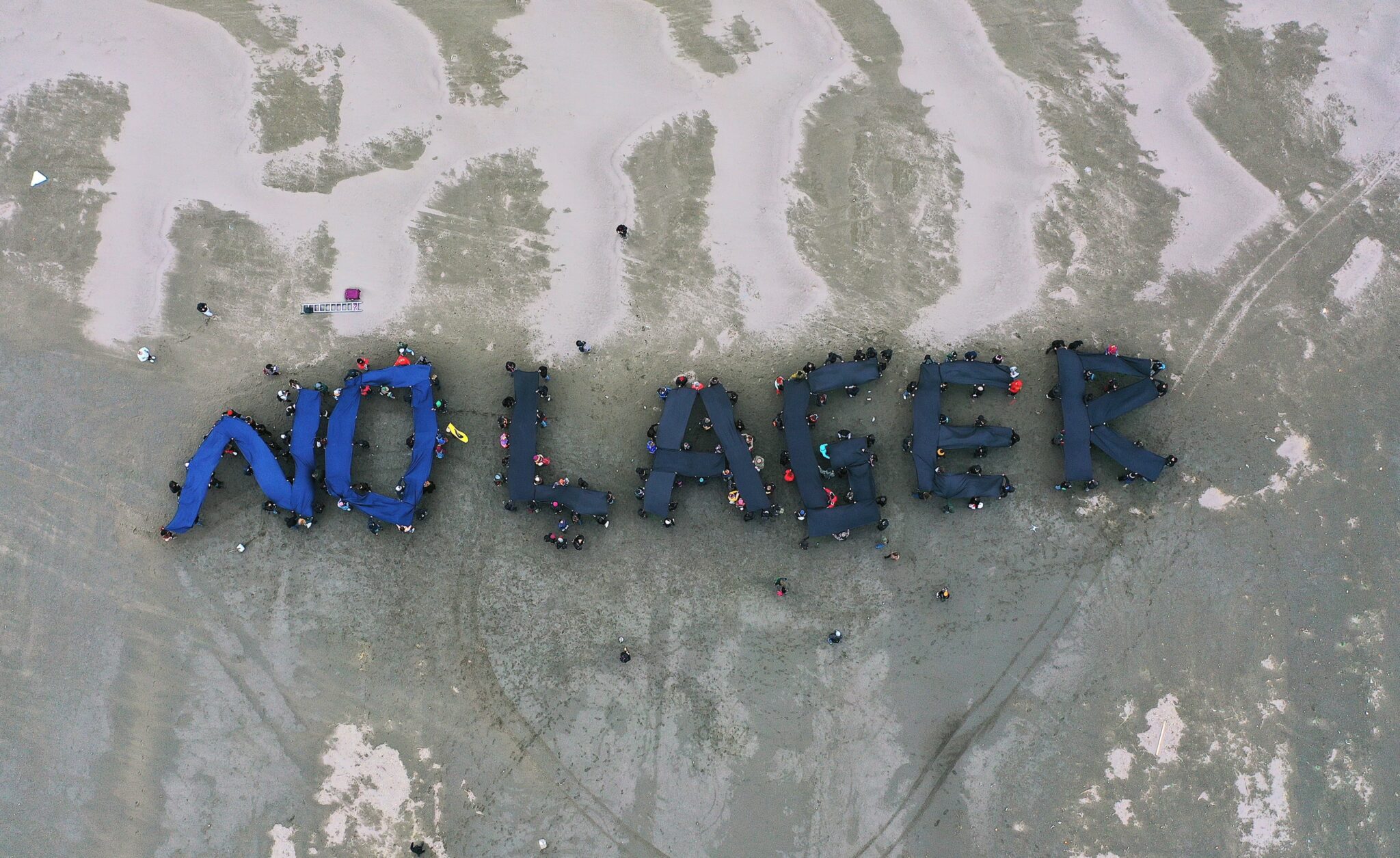
Picture from the call for a mobilisation against the centers in Albania. Source: municipiozero.it
On 21 November, the Humanity 1 rescued 70 people who had alerted Alarm Phone in distress at sea. They had left Libya already two days earlier and their boat had lost a lot of air and was in danger of sinking.
On 22 November, the National Federation of the Orders of Surgeons and Dentists (FNOMCeO) had a meeting in Rome. They declared in a motion that responded to the reports of some humanitarian organizations regarding the health risks for migrants rescued at sea and the methods and times for the selection of non-vulnerable people who can be transferred to dedicated centers in Albania: “The selection of migrants is not a treatment process”.
On 23 November, the crew of Sea-Watch 5 rescued 49 people from distress at sea. The people had alerted Alarm Phone, as their rubber dinghy had already lost a lot of air and the engine had stopped.
On 24 November, Italian police and social workers left Albania. The centres had been open for over a month but received just 24 asylum seekers, whose detention was deemed unlawful.
On 26 November, media reported that hundreds of migrants had been detained in the Libyan desert. Libyan military officials said they had rounded up more than 300 people crossing the country’s desert en route to the Mediterranean.
On 27 November, Libyan police jointly with fishermen rescued eight people on the move and recovered four bodies from a boat that capsized off Ras Lanauf, Libya.
On 28 November, the crew of Humanity 1 reported about a rescue of 47 people shortly before midnight. This rescue was unusual and dangerous for the crew and the rescued people: an overcrowded boat had moved towards the Humanity 1 at high speed. There were four masked men on board who forcibly pushed the 47 people off the boat. After consulting with the Italian Maritime Rescue Coordination Centre, the crew was able to bring the people in distress on board the Humanity 1. The four masked men remained on their boat and left immediately. According to the reports of survivors, the men were members of the so-called Libyan Coast Guard.
On the same day, the MSF team on the Geo Barents witnessed a similar incident while arriving to rescue people in distress on a deflating rubber boat, with armed men on a fast boat in their close vicinity. Survivors reported that 29 women and children had been intercepted at gunpoint before the Geo Barents had arrived. Armed men had threatened the people on the rubber boat and shot in the air, causing over 70 people to jump in the water. MSF team rescued everyone from the water and the rubber boat, but the fast boat left with the 29 women and children on board.
On 29 November, several ships of the civil fleet rescued people who had alerted Alarm Phone: The Humanity 1 rescued 46 people and the new sailing ship Safira of Mediterranea rescued 77 people. Also the Aita Mari, Life Support and Geo Barents performed rescues. 49 people who had alerted Alarm Phone were rescued and brought to Sicily by the Italian Coastguard. 35 people in the Maltese SAR zone were forcibly returned to Libya.
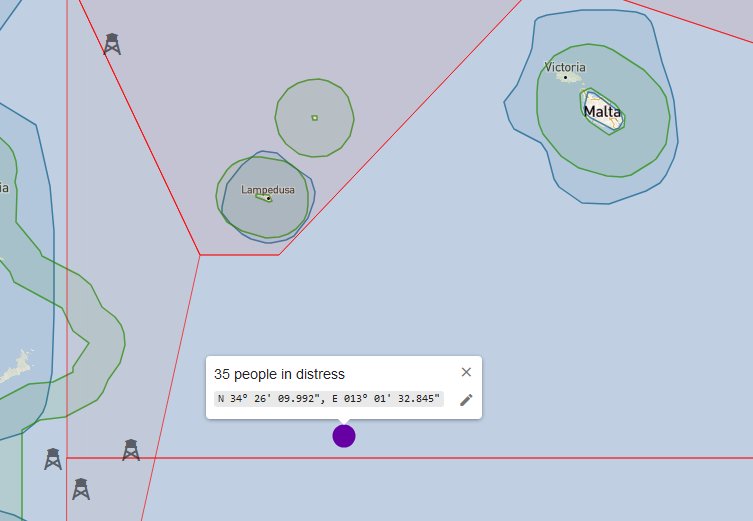
Map showing the position of the boat that was forcibly returned to Libya. Source: Alarm Phone
On 30 November, the Greek Coastguard told us that they had found and rescued 64 people who had alerted Alarm Phone a day before on the way from Tobruk, eastern Libya, towards Crete.
On the same day, Alarm Phone alerted authorities to two boats in the Maltese SAR zone. Two days later, we learned that one of them, carrying 70 people, was pushed back by a merchant vessel to Libya in coordination with the so-called Libyan Coastguard. The other one with 83 people on board was rescued by a merchant vessel to Malta on 3 December.
December
In December, Alarm Phone was alerted to 67 boats in distress, among them 52 departing from Libya, 14 from Tunisia, and one from an unknown departure place. NGO vessels rescued a total of nine boats that month – not all of them had alerted Alarm Phone. One boat was rescued by a merchant vessel to Greece. The Italian Coastguard rescued at least four boats. Often, they rescued boats when they had almost reached Lampedusa, and they also coordinated some rescue operations of boats heading towards Sicily or Calabria. We know of twelve interceptions by the so-called Libyan coastguard. About Tunisian interceptions we rarely receive reliable figures – this month we learned about four, but there were many more. We know of ten shipwrecks (several of them Alarm Phone cases) in December.
On 1 and 2 December, protests against detention camps in Albania took place, first a demonstration in Tirana, then another one at the centers in Gjadër and Shëngjin.
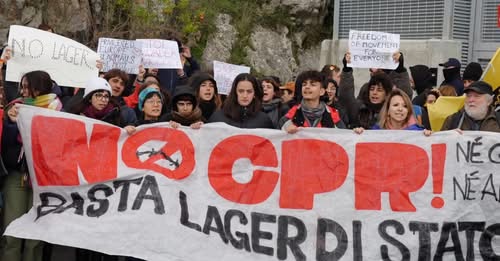
Photo of the demonstration against the detention center in Gjadër. Source: https://www.facebook.com/story.php?story_fbid=989934286497864&id=100064439062681&rdid=NU8v79kT1fRVWsIE
On 2 December, Alarm Phone was informed about two boats that had gone missing off Sfax, Tunisia. One was carrying 47 people, the other one 75 people, both were iron boats and had left several days before. Worried relatives were contacting us. Authorities said they did not have any information about these boats.
On 4 December, the Court of Cassation ruled that the decision on the appeals presented by the Italian government against the first failures to validate the detention of asylum seekers in repatriation detention centers in Albania “will be made known in the coming weeks.” During the hearing, the general prosecutors had asked the magistrates to “suspend the judgment” pending the ruling of the Court of Justice of the EU, which will probably come in spring 2025.
On 5 December, several Search and Rescue NGOs published a joint statement against the “Flows Decree“ which was approved in the Italian Senate a day before. The NGOs expressed strong concern over yet another attempt by the Italian government to punish assistance to people in distress at sea and to criminalize NGOs.
On 11 December, the sailing ship Trotamar III rescued a young girl, the sole survivor of a boat from Sfax, carrying more than 40 people, that had capsized three days before. The 11-year-old girl, wearing a life vest and clinging to a pair of tyre tubes, was rescued off the Italian island of Lampedusa.
On the same day, Alarm Phone reported about two other boats departing from Tunisia that had shipwrecked. We had been alerted to about 130 people on a large wooden boat near Sfax. According to the people in distress, the boat had capsized, at least two people had died and many were still in the sea. In another shipwreck off the Tunisian coast, 27 people were rescued, nine bodies were found and many remained missing.
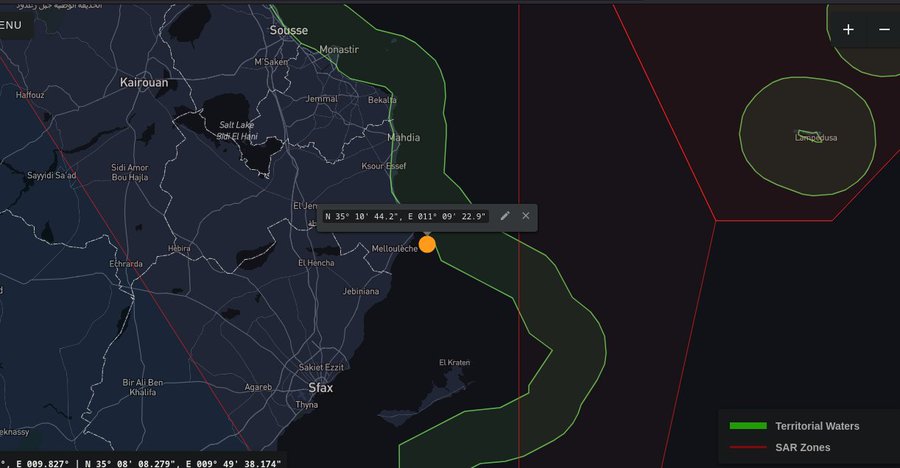
Map showing the position of the boat near Sfax, Tunisia. Source: Alarm Phone
On 12 December, the Ocean Viking rescued 34 people from a rubber boat off Libya. One hour after the rescue was completed, a Libyan coastguard asset approached at fast speed, crossing the Ocean Viking’s bow, ordering them to leave despite operating in international waters. The Libyan boat then left the scene, abruptly ending the radio exchange.
On 13 December, Alarm Phone was in contact with two boats in urgent distress, one off Libya, carrying 37 people who were later found by the merchant vessel Lena and returned to Libya. The other boat with about 60 people on board was in the SAR zone of Malta. A Frontex asset was watching them from the skies, but nobody intervened for a long time. We did not get a final confirmation, but we think that this group was eventually rescued to Lampedusa.
On the same day, Greek media outlets reported that a boat with about 80 people shipwrecked 12,5 nautical miles southwest of the island of Gavdos, near Crete. 37 were rescued, among them several injured. One day later, the death toll had risen to five and the Greek Coastguard said it had rescued 39 people from the sea and launched a search operation for the dozens missing. We could not verify if this was the same boat that had alerted us in distress. There was also a second incident that occurred 40 nautical miles south of Gavdos with the rescue of 47 migrants by a cargo vessel and at dawn a third incident 28 nautical miles south of Gavdos with the rescue of 88 migrants by a tanker.
On 14 December, Alarm Phone was in contact with a boat carrying 63 people that was adrift. We learned that this boat was rescued by the NGO ship ResQ-People.
On the same day, Alarm Phone was in contact with a boat in distress off Tunisia with 47 people on board. The people reported that one person had fallen into the sea. We lost contact, but two days later relatives informed us that the people were found by the Tunisian Coastguard and brought to land.
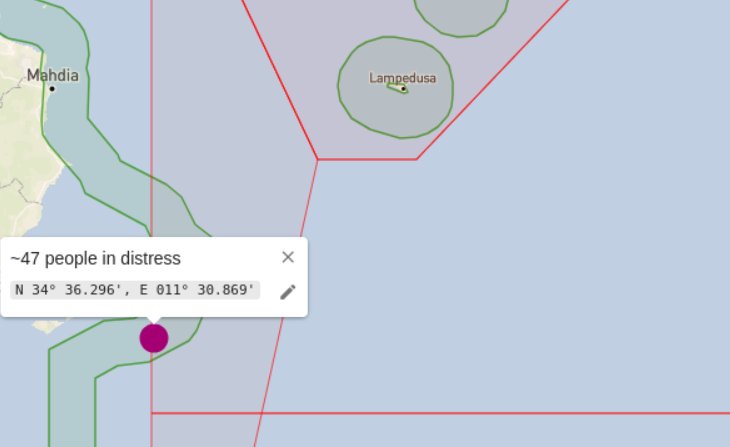
Map showing the position of the boat in distress off Tunisia. Source: Alarm Phone
On 15 December, a boat carrying 55 people that had alerted Alarm Phone in distress arrived in Lampedusa. Media reported that 50 people (unclear whether this was the same incident) had arrived on a Frontex patrol boat.
On 16 December, Libyan media outlets reported that after the fall of the Assad regime in Syria, Russia had begun moving naval assets from Syria to Libya and had increased pressure on Khalifa Haftar to secure Russia’s claim to a port in Benghazi.
On 18 December, Alarm Phone alerted authorities to a boat that was taking in water quickly. A relative had told us about the urgent distress of the 96 people. One day later, we had to learn that rescue had not come in time. The so-called Libyan Coastguard found 82 people, but several people had gone missing. Some sources spoke of about 15 deaths.
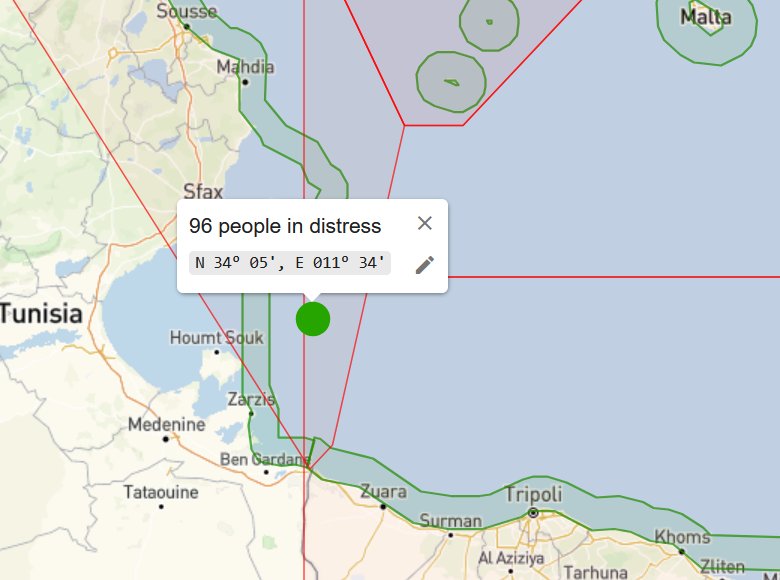
Map showing the position of the boat in urgent distress. Source: Alarm Phone
On 19 December, another shipwreck off Sfax was reported. Five survivors were rescued by the Tunisian National Guard, 20 people died.
On the same day, over 230 people arrived at Lampedusa with Frontex and Italian Coastguard patrol boats.
On 20 December, Matteo Salvini, the leader of the right-wing Lega, emerged victorious from the trial in which he was charged with deprivation of liberty of the survivors aboard the Open Arms rescue ship for 19 days in August 2019. The presiding judge announced the acquittal, while the reasons for this will only be made public later. However, the NGO Open Arms has already announced that it would appeal Salvini’s acquittal.
On 23 December, the Meloni government challenged Italian judges and announced that the “Operation Albania“ would restart. From January on, the Libra ship would be operational again, ready for transfers.
On 25 December, after Italy’s conviction in the Asso29 case, the first illegally rejected migrant arrived in Rome. “A.” had attempted to cross the Mediterranean in 2018. However, along with 270 other people, he had been handed over to the Libyan authorities on the orders of the Italian authorities, after being intercepted by the Italian merchant ship Asso 29. In June 2024, the civil court of Rome found the ministries of Defense and Transport, the Presidency of the Council, the captain and the owner of the Augusta Offshore vessel guilty. After yet another appeal by ASGI, “A.” entered Italy with a regular visa.
On 30 December, the rescue ship Aurora secured 56 people on a boat reported by Alarm Phone until the Italian Coastguard arrived to take them onboard. They were brought to Lampedusa.
On the same day, hundreds of arrivals were reported. In a short window of good sea conditions, 747 people had disembarked in Lampedusa.
On 31 December, we learned about at least six shipwrecks from Libya and Tunisia, several of them Alarm Phone cases. With sadness and anger, we published a list of the deadly shipwrecks in the Mediterranean and in the Atlantic that we knew of – hundreds of people who lost their lives in December alone, leaving thousands of relatives and friends in great despair and sadness. Even worse, we know that this is only the tip of the iceberg.
Also on this last day of the year, we thanked the crews of merchant vessels for their often invisible but essential assistance at sea: “We have seen how you carry out rescues no matter the weather conditions, even though when the waves are high it is dangerous for you as well.“
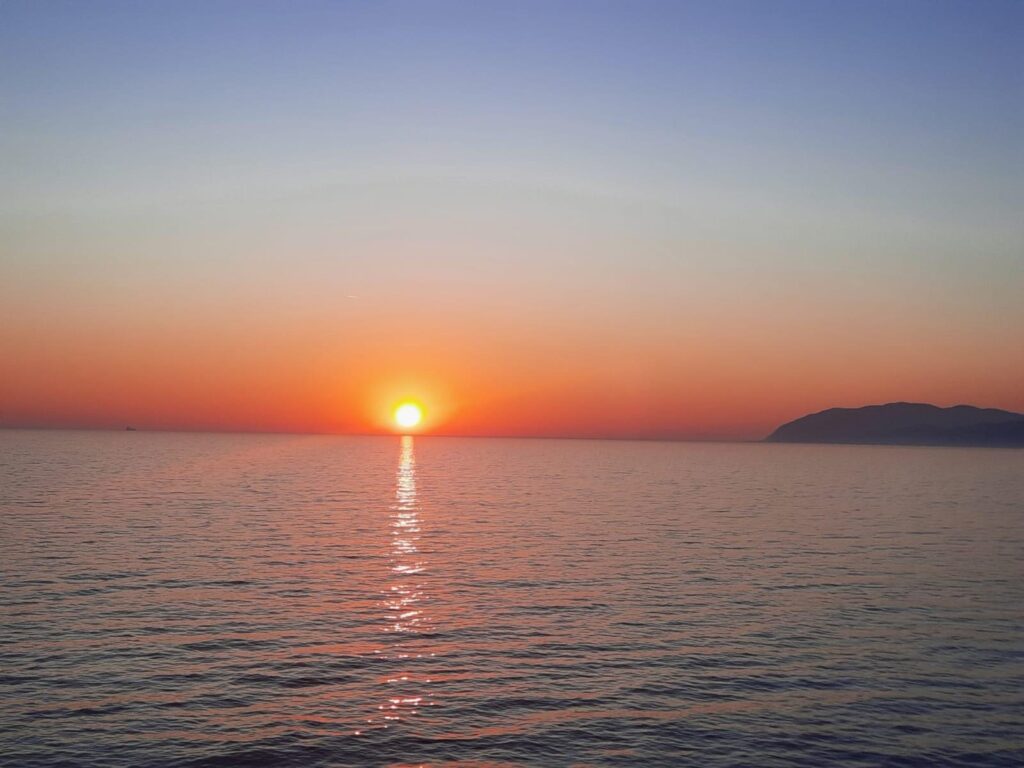
Photo: Alarm Phone